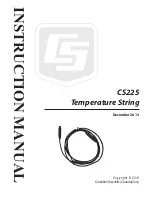
u
oPE02 Error Occurs When Lowering the Motor Rated Current Setting
Cause
Possible Solutions
Motor rated current and the motor no-load current
setting in the drive are incorrect.
• The user is trying to set the motor rated current in E2-01 to a value lower than the no-load
current set in E2-03.
• Make sure that value set in E2-01 is higher than E2-03.
• If it is necessary to set E2-01 lower than E2-03, first lower the value set to E2-03, then change
the setting in E2-01 as needed.
u
Motor Stalls during Acceleration or Acceleration Time is Too Long
Cause
Possible Solutions
Current suppression prevents the drive from
accelerating.
Take the following steps to resolve the problem:
• Reduce the load.
• Increase motor capacity.
Note:
Although the drive has a Stall Prevention function and a Torque Compensation
function, accelerating too quickly or trying to drive an excessively large load can
exceed the capabilities of the motor.
Load is too heavy.
Frequency reference is too low.
Set E1-03 to a pattern with a higher input frequency.
Check U1-01 for proper frequency reference.
Check if a frequency reference signal switch has been set to one of the multi-function input
terminals.
Check for low gain level set to terminals A1 or A2 (H3-03 or H3-11).
Load is too heavy.
Reduce the load so that the output current remains within the motor rated current.
• Increase the acceleration time.
• Check if the mechanical brake is fully releasing as it should.
Acceleration time has been set too long.
Check if the acceleration time parameters have been set too long (C1-01).
Motor characteristics and drive parameter settings are
incompatible with one another.
• Set the correct V/f pattern so that it matches the characteristics of the motor being used.
• Check the V/f pattern set to E1-03.
Incorrect frequency reference setting.
• Check the multi-function analog input settings. Multi-function analog input terminals A1 or
A2 are set for frequency gain (H3-02 or H3-10 are set to 1), but there is no voltage or current
input provided.
• Make sure H3-02 and H3-10 are set to the proper values.
• See if the analog input value is set to the right value (U1-13 and U1-14).
The Stall Prevention level during acceleration and
deceleration set too low.
• Check the Stall Prevention level during acceleration (L3-02).
• If L3-02 is set too low, acceleration may be taking too long.
• Increase L3-02.
The Stall Prevention level during run has been set too
low.
• Check the Stall Prevention level during run (L3-06).
• If L3-06 is set too low, speed will drop as the drive outputs torque.
• Increase the setting value.
Drive reached the limitations of the V/f motor control
method.
• The motor cable may be long enough (over 50 m) to require Auto-Tuning for line-to-line
resistance.
• Be aware that V/f Control is comparatively limited when it comes to producing torque at low
speeds.
u
Drive Frequency Reference Differs from the Controller Frequency Reference Command
Cause
Possible Solutions
The analog input gain and bias for the frequency
reference input are set to incorrect values.
• Check the gain and bias settings for the analog inputs that are used to set the frequency reference.
Check parameters H3-03 and H3-04 for input A1 and check parameters H3-11 and H3-12 for
input A2.
• Set these parameters to the appropriate values.
A frequency bias signal is being entered via analog
input terminals A1 to A2.
• If multi-function analog inputs A1 and A2 are set for frequency reference bias (H3-02 or H3-10
is set to 0), then the sum of all signals builds the frequency reference.
• Make sure that H3-02 and H3-10 are set appropriately.
• Check the input level set for terminals A1 and A2 (U1-13 and U1-14).
6.9 Troubleshooting without Fault Display
YASKAWA ELECTRIC SIEP YAIZ1B 01E YASKAWA AC Drive – Z1000 Bypass Technical Manual
261
6
Diagnostics & Troubleshooting
















































